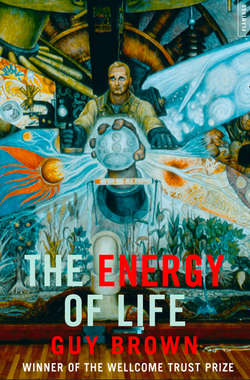The Energy of Life:

Реклама. ООО «ЛитРес», ИНН: 7719571260.
Оглавление
Guy Brown. The Energy of Life:
THE. ENERGY. OF LIFE. GUY BROWN
Copyright
CONTENTS
Introduction
Chapter 1 ORIGINS
Chapter 2 THE STORY OF LIVING ENERGY
THE ELEMENTS, HUMOURS AND SPIRITS OF THE CLASSICAL WORLD
THE ENLIGHTENMENT
THE REVOLUTION
THE VITAL FORCE
THE BIRTH OF ENERGY
Chapter 3 ENERGY ITSELF. WHAT IS ENERGY?
THE SECOND LAW AND THE SECRET OF LIFE
Chapter 4 THE MACHINERY OF LIFE
Chapter 5 THE BODY ELECTRIC
Chapter 6 MITOCHONDRIA: THE MONSTERS WITHIN
Chapter 7 THE PACE OF LIFE AND DEATH
Chapter 8 GETTING FAT AND STAYING THIN
THE FUEL SUPPLY
WHY DO WE GET FAT?
Chapter 9 EXERCISE, FATIGUE AND STRESS
THE SPEED LIMIT
THE MIRACLE OF MOTION
WHO CONTROLS THE ENERGY?
ADRENALINE AND STRESS
Chapter 10 MIND ENERGY
THE ORIGINS OF MIND ENERGY
AROUSAL AND TENSION
THE PSYCHOLOGY OF ENERGY
Chapter 11 BRAIN ENERGY. THE MIND AND ITS MESSENGERS
BRAIN STIMULANTS
ENERGY IN THE BRAIN
Chapter 12 SEX AND SLEEP. SEXUAL ENERGY
SLEEP AND SLEEPINESS
Chapter 13 MOOD, MADNESS AND CREATIVE ENERGY
MOOD AND HEALTH
CREATIVE ENERGY AND MANIA
Chapter 14 HOW TO GET MORE ENERGY
Sources and Further Reading. Chapter 1. ORIGINS
Chapter 2. THE STORY OF LIVING ENERGY
Chapter 3. ENERGY ITSELF
Chapter 4. THE MACHINERY OF LIFE
Chapter 5. THE BODY ELECTRIC
Chapter 6. MITOCHONDRIA: THE MONSTERS WITHIN
Chapter 7. THE PACE OF LIFE AND DEATH
Chapter 8. GETTING FAT AND STAYING THIN
Chapter 9. EXERCISE, FATIGUE AND STRESS
Chapter 10. MIND ENERGY
Chapter 11. BRAIN ENERGY
Chapter 12. SEX AND SLEEP
Chapter 13. MOOD, MADNESS AND CREATIVE ENERGY
Chapter 14. HOW TO GET MORE ENERGY
Glossary
Index
Acknowledgements
About the Author
About the Publisher
Отрывок из книги
Cover
Title Page
.....
Between 1750 and 1775, the main gases were discovered by British chemists: carbon dioxide by Joseph Black in 1757; hydrogen by Henry Cavendish in 1766; nitrogen by Daniel Rutherford in 1772; and oxygen independently by Joseph Priestley in 1774 and the Swedish chemist Karl Scheele in 1772. However, these gases were not considered distinct chemical substances, but rather, types of air, as Empedocles’ four elements theory still held sway – 2,200 years after his death. So, for example, carbon dioxide was known as fixed air, and oxygen as dephlogistonated or fire air. But the scientific stage was set for a revolution: the overthrow of the four elements, the extinction of phlogiston, the rejection of vitalism, and for the creation of chemistry and physiological chemistry.
Lavoisier was an unlikely revolutionary: his father was a lawyer and his family was part of the prosperous French bourgeoisie. He received the best possible education and studied law, gaining an interest in chemistry from a family friend. The French Academy of Sciences had been in existence since 1666, and at only 21, Lavoisier decided he wanted to be a member. He successfully investigated various methods of public street lighting, and was awarded a gold medal by the king and at just 25 was elected to the Academy. He then embarked on the series of chemical experiments that was to reshape the world of science. But, like most other contemporary scientists, he had to finance his own experiments, so he used his maternal inheritance to purchase membership of a tax-collecting firm. While this provided him with financial security, it was to eventually prove fatal, as tax collectors were not popular at all after the French Revolution. His career did, however, also provide him with an introduction to his thirteen-year-old future wife, Marie, the daughter of another tax collector. This turned out to be a wise move, as Marie rapidly became a proficient scientist herself, serving as an able assistant to all Lavoisier’s works.
.....